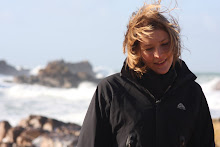
Took a walk up to the water tank on top of the village. Our house is one of the four in the village that has water rights. This means, the tank, fed by the mountain stream, leads down the mountain, through the village pools (which are cleaned in the summer to make swimming pools)and into our garden.
The channels (in the picture) flow through our garden. To walk along the channels down the mountain today was really lovely. It felt very ancient (although the cannels are probably not that old). If anyone has read, Driving Over Lemons, it is much like his experience of walking with the water.
After we tested the water, it started to pour down! It's going to rain for the next five days we are told! Oh well, a good chance to learn some Portuguese.

This is great Helen. I can get a real feel of what is going on. If only I were 30 years younger!!!! If it makes you feel any better, forecast is for rain (and ash) here. Patx
ReplyDelete